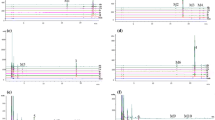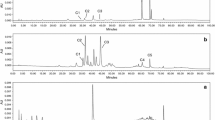Abstract
Neohesperidin as the major isoflavonoid in Aurantii Fructus has been investigated intensively. However, the route and metabolites of neohesperidin by human intestinal bacteria are not well understood and its metabolites may accumulate and exert physiological effects. In this work, 5 strains including Clostridium sp.8, Bacteroides sp.15, Bacillus sp.46, and Enterobacter sp.41-1 and sp.73 were isolated and their abilities to convert neohesperidin were studied. Human fecal microflora were prepared from a healthy Chinese woman and then anaerobically incubated with neohesperidin sample at 37 °C for 48 h. A rapid and simple liquid–liquid extraction method was used for sample pretreatment. A highly sensitive and specific ultra performance liquid chromatography/quadrupole time-of-flight mass spectrometry with MetaboLynx™ method has been developed for the analysis of neohesperidin and related metabolites in the reaction samples. The chromatographic separation was performed on a 1.7 μm particle size Syncronis C18 column using gradient elution system. The components in the extract were identified and confirmed according to the mass spectrometric fragmention mechanisms, MS/MS fragment ions and relevant literature by means of electrospray ionization mass spectrometry in negative ion mode. With this method, a total of five metabolites were detected, the results indicated that hydrolysis, dehydroxylation, demethylation and acetylation were the major metabolism of neohesperidin. The present study provided important information about the metabolism of neohesperidin which will be helpful for fully understanding the impact of the intestinal bacteria on this active component. Furthermore, this work demonstrated the potential of the ultra performance liquid chromatography/quadrupole time-of-flight mass spectrometry approach using MetaboLynx™ for quite rapid, simple, reliable and automated identification of metabolites of natural product.



Similar content being viewed by others
References
Tong L, Zhou DD, Gao J, Zhu YH, Sun H, Bi KS (2012) J Pharmaceut Biomed 58:58–64
Zhang JK, Sun CD, Yan YY, Chen QJ, Luo FL, Zhu XY, Li X, Chen KS (2012) Food Chem 135:1471–1478
Bellocco E, Barreca D, Laganà G, Leuzzi U, Tellone E, Ficarra S, Kotyk A, Galtieri A (2009) Mol Cell Biochem 321:165–171
Uchiyama N, Kim IH, Kikura-Hanajiri R, Kawahara N, Konishi T, Goda Y (2008) J Pharmaceut Biomed 46:864–869
Hwang SL, Yen GC (2008) J Agric Food Chem 56:859–864
Xu FG, Liu Y, Zhang ZJ, Song R, Yang C, Tian Y (2007) Chromatographia 66:763–766
Xu F, Zang J, Chen DZ, Zhang T, Zhan HY, Lu MD, Zhuge HX (2012) Nat Prod Commun 7:1475–1478
Lee JH, Lee SH, Kim YS, Jeong CS (2009) Phytother Res 23:1748–1753
Del Rio J, Fuster MD, Sabater F, Porras I, Garcia-Lidon A, Ortuno A (1997) Food Chem 59:433–437
Kim DH, Yu KW, Bae EA, Park HJ (1998) Biol Pharm Bull 21:360–365
Lee JE, Lee S, Sung J, Ko G (2011) ISME J 5:362–365
Jaganath IB, Mullen W, Lean MEJ, Edwards CA, Crozier A (2009) Free Radic Bio Med 47:1180–1189
Matthies A, Blaut M, Braune A (2009) Appl Environ Microbiol 75:1740–1744
Panagiotidis G, Backstrom T, Asker-Hagelberg C, Jandourek A, Weintraub A, Nord CE (2010) Antimicrob Agents Chemother 54:1811–1814
Hur H, Lay J, Beger J, Freeman J, Rafii F (2000) Arch Microbiol 174:422–428
Xue CF, Jiang S, Guo JM, Qian DW, Duan JA, Shang EX (2011) J Chromatogr B 879:3901–3908
Sun MQ, Lu JQ, Zhang HG, Zhang QS, Xiao N, Xi RY (2010) Chem Res Chin Univ 26:27–32
Fabre N, Rustan I, de Hoffmann E, Quetin-Leclercq J (2001) J Am Soc Mass Spectrom 12:707–715
Xu FG, Liu Y, Zhang ZJ, Yang C, Tian Y (2009) Chin Med 4:1–10
Shimoda K, Kubota N, Taniuchi K, Sato D, Nakajima N, Hamada H, Hamada H (2010) Phytochemistry 71:201–205
Hou YC, Hsiu SL, Huang TY, Yang C, Tsai SY, Chao PD (2001) Planta Med 67:538–541
Choi EJ (2008) Life Sci 82:1059–1064
Pollard SE, Whiteman M, Spencer JP (2006) Biochem Biophys Res Commun 347:916–923
Hirata A, Murakami Y, Shoji M, Kadoma Y, Fujisawa S (2005) Anticancer Res 25:3367–3374
Choi EJ, Ahn WS (2008) Arch Pharm Res 31:1457–1462
Acknowledgments
This work was financially supported by National Basic Research Program of China (973 Program) (2011CB505300, 2011CB505303); Key Research Project in Basic Science of Jiangsu College and University (10KJA360039); Construction Project for Jiangsu Key Laboratory for High Technology Research of TCM Formulae (BM2010576). We are also pleased to thank Waters China Ltd. for technical support.
Author information
Authors and Affiliations
Corresponding author
Rights and permissions
About this article
Cite this article
Zhang, W., Jiang, S., Qian, D. et al. Determination of Metabolism of Neohesperidin by Human Intestinal Bacteria by UPLC-Q-TOF/MS. Chromatographia 77, 439–445 (2014). https://doi.org/10.1007/s10337-014-2625-9
Received:
Revised:
Accepted:
Published:
Issue Date:
DOI: https://doi.org/10.1007/s10337-014-2625-9




